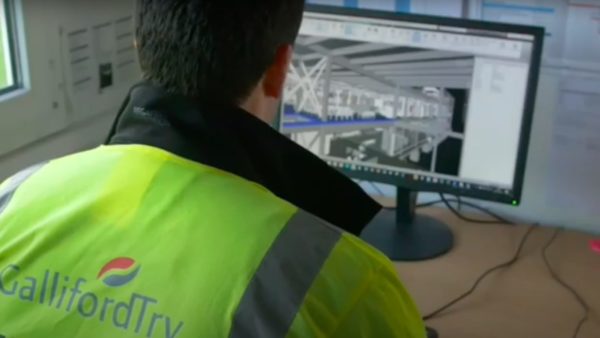Robots are becoming smarter and more accessible than ever. Some are now capable of repairing live pipes, explains Darren Bond, BIM consultant and director at BIM and CAD service provider GlobalCAD.
Following visits to several major UK construction sites, prior to the pandemic, it’s clear that drones are now becoming mainstream for surveys and monitoring. But these Unmanned Aerial Vehicles are not the only independent machines to be found on site. Robots are also developing quickly and some are now even capable of repairing pipes without shutting off the power – and the implications for UK infrastructure are huge.

The robots use an air coupling to connect with UV patching and spot repair packers. They can carry out trenchless pipe repairs inside pipes ranging from 150mm to 500mm diameter.– Darren Bond, GlobalCAD.
A total of 1.5 million road excavations take place every year in the UK. The traffic closures and disruption to businesses are estimated to cost more than £5bn – that’s almost 5% of the entire construction turnover in the UK. In my opinion, we should be looking at innovative ways of eliminating or reducing such waste and I think we are heading in the right direction. The UK government has committed £26.6m to build microrobots that can help repair our vast underground pipe network. These robots will not only help to repair underground pipes but also offshore oil and gas pipelines and wind turbines.
When the UK announced this investment in December 2018, science minister Chris Skidmore said: “While for now we can only dream of a world without roadworks disrupting our lives, these pipe-repairing robots herald the start of technology that could make that dream a reality in the future.”
Although this research project started last year, there are other robots already working on site. For example, we can already find robots being used for pipe inspections and small repairs. Recently, I came across Sewer Robotics, a company that creates robots capable of identifying small cracks inside sewer pipes – and they can repair them too. The robots use an air coupling to connect with UV patching and spot repair packers. They can carry out trenchless pipe repairs inside pipes ranging from 150mm to 500mm diameter. You have read correctly – trenchless pipe repairs… Imagine not having to experience disruption again when a pipe outside your home or office has a leak.
London project
Another big innovator in this area is Cadent – the largest gas provider in the UK. Last year it started a £2.5m project to fix underground pipes in London with a robot. Developed by ULC Robotics, it is called Cisbot (very robotic indeed). This robot can repair 100 metres of gas mains in seven days. If the same work was to be undertaken by human workers, it would instead take 10 weeks. It’s not only 10 times faster, but it also minimises disruption thanks to its trenchless repairs. What’s even more remarkable to me, as a BIM consultant in the construction sector, is the fact that it improves safety by removing many man-hours on site and doing the “hard work” for them.
Another significant benefit is that Cisbot can work inside live pipes. Thanks to this feature, Cadent has been able to carry out repairs to multiple pipes in London whilst maintaining the gas supply to neighbours. The robot only needs one excavation to be lowered into the ground and into the gas main. Once inside, it can be controlled remotely by an operator on the surface. When a crack is identified, the robot can inject a sealant and voila! – job done without endless trenches.
The future of pipe repairs with robots
Cisbot has set the bar for the future of robots and pipe repairs. One of the most exciting and promising projects is the FSWBot – Friction Stir Welding Robotic Crawler. This robot can repair offshore pipes without stopping the associated service flow. It uses innovative technology for friction stir welding. Thanks to this, it generates enough frictional heat to soften the metal without melting it. This, in turn, allows metal components to be forged together at the joint line.
The FSWBot is currently being developed by Forth Engineering in Cumbria. The funding comes from Innovate UK and it is expected to be operational by January 2021.
When the project was unveiled last November, Peter Routledge, project manager at Forth Engineering, said: “The project is creating interest in the oil, water, waste, recycling and renewables industries, all looking at how they could apply it to make them more efficient.”
I find the robot’s pipe repair method particularly fascinating. Once deployed inside a cast-iron pipeline with oil flowing, it will lock itself at the position where the repair is needed. The robot has a turbine within a duct which uses the kinetic energy in the flow of oil to power the milling tool. Once it has accumulated enough energy, the milling tool will cut away the corroded area and put in place a steel patch.
The FSW unit will then weld the patch in place and use the milling tool to ensure it is flush with the pipe. Finally, the robot will deploy non-destructive test packages to inspect the weld for quality assurance. A clean, complete job, without stopping the flow of oil in the pipe.
Futuristic? Not really – most likely a reality from next year.
Comments
Comments are closed.
















Repairing gas mains robotically truly is a game changer for congestion issues in all major UK cities (and the world!). I understand these bots can travel long distances too. The trials that took place under the Strand were in old Victorian leaky pipes so they can handle tough environments. Looking forward to hearing more as this technology evolves!
We have a Cisbot under Kings Road, Chelsea at present but its not a fast process. Its been there over two weeks already, blocking traffic. There is no getting away from the need for an entry point.
That’s what robots should be used for to do work where the work force can’t easily and safely go.
Artificial intelligence is growing up fast, and is changing the construction culture one robot at a time creating potential reductions on incident, accident rates on site, work effectiveness, minimizing deficiency by utilizing AI inspections, fast-racking construction schedules and host of others. Cisbot technology offers convenience, wealth and the lessening burden of physical labour via its automated systems.